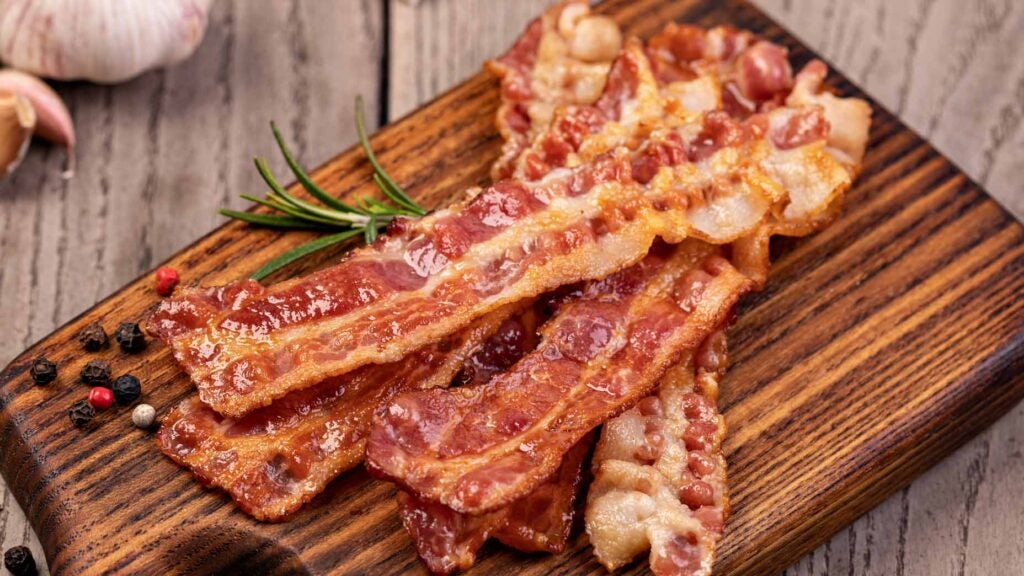On the course, we like to ham-and-egg it. But bacon is our preference when it comes time for a meal. Todd Warden is a bacon-lover, too. As executive chef at Core 450, a soon-to-open restaurant at Cherokee Valley Club, in South Carolina, he makes his own bacon, rubbing pork belly in salt and other seasonings and leaving it to cure, sealed, in the fridge (see recipe below). But because the rest of us just bring home the bacon, we asked Warden for advice on how to cook it right.
1. Bakin’ bacon
This is Warden’s preferred method, as it is simpler, more consistent and creates less of a mess than stovetop frying. Just lay your bacon slices on a sheet pan covered with parchment paper, and then bake at 350 degrees for 15 to 20 minutes (cooking times may vary depending on your oven). When the bacon has crisped up to your liking, remove it to drain on paper towels until you’re ready to serve it. Don’t leave the bacon sitting in its own grease on the pan, Warden cautions, or it will reabsorb the fat and lose its crispiness. If you prefer your bacon soft, not crispy, simply cook it for less time, removing it from the oven when it reaches the consistency you like.
2. Microwave? Meh
Bacon can be nuked, but just because you can doesn’t mean you should. “Chances are it’s going to wind up either too rubbery or too crispy,” Warden says. “It’s just a subpar product,” he adds, and not worth whatever time you save.
3. Candied bacon
Just when you thought bacon couldn’t get any better, along comes this sweet, spicy, crackling variation. Warden makes his by rubbing bacon slices with brown sugar (about a teaspoon to a teaspoon-and-a-half of brown sugar per slice should do), sprinkling them with cracked black pepper and setting them on a wire rack lightly coated with non-stick spray. Place that wire rack on a sheet pan covered with parchment paper (this will save you the serious cleanup headache of scraping burnt sugar from the pan) and bake it at 350 for 15 to 20 minutes, until the bacon is crisped with a beautiful candied coating. Note: be sure to take bacon off the rack while it’s still warm. If you let it cool, it’s liable to stick to the rack and crack when you try to remove it later.
4. Stovetop bacon
A commonplace method, with pros and cons. Aside from the smoke and the greasy cleanup, Warden’s main beef with it is that the edges of the bacon tend to curl up in the pan, yielding a less evenly cooked result than what you get in the oven. If you opt for this approach, Warden recommends using a cast iron skillet and cooking the bacon at low heat, which allows time for the fat to render without burning the meat. Warden often opts for the stovetop method when he’s using the bacon as an ingredient in other dishes, such as salads, omelets or chowders.
In those instances, he chops the bacon before putting it in the pan and lets it crisp up in pieces. If your pan has a hotspot, and some bacon pieces are cooking faster than the others, you can prevent those pieces from burning by splashing a small amount of water on them to dissipate the heat. Warden also saves the rendered fat from the pan, using it for salad dressings (sherry bacon vinaigrette, anyone?), roux, or for sautéing vegetables. If you don’t plan on using the bacon fat right away, Warden says you can store in an airtight container and put it in your fridge, where it will last for months.
5. House-cured bacon
If you’ve got the time and the ambition, you can do like Warden and cure your own bacon. Here’s his recipe.
Ingredients:
-2 1/2-3 pounds pork belly
-1/3 cup sugar (brown or white)
-1 tablespoon sweetener, such as molasses, maple syrup or honey
-3 tablespoons kosher salt
-1 teaspoon curing salt (pink salt)
-1 tsp of coarsely ground black pepper, coriander or any other desired spice
Preparation:
1. Rinse and dry the pork belly (its surface should feel tacky)
2. In a bowl, mix sugar, sweetener, salt and seasonings and rub the entire belly generously with the medley.
3. Place the pork belly in zip-lock bag and refrigerate for 7 to 10 days, flipping the meat and rubbing in the spice mix daily
4. You can tell the pork belly has cured when it gets firm to the touch
5. Rinse the meat well, pat dry and smoke over desired wood (smoking is an optional step that imparts deeper flavor)
6. Place in a 250-degree oven and cook until the internal temperature is 150 degrees (45-90 minutes, depending on the thickness of the cut)
